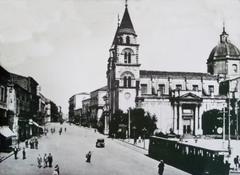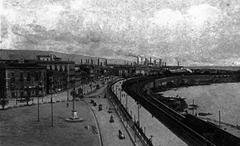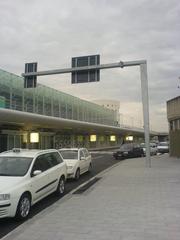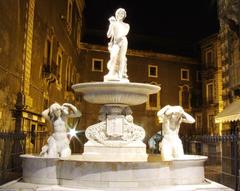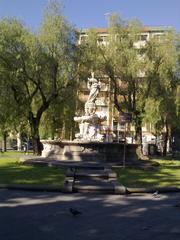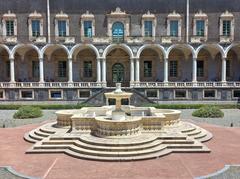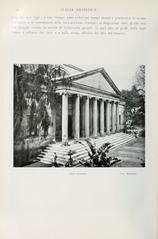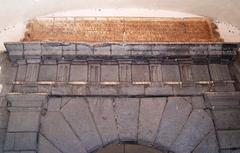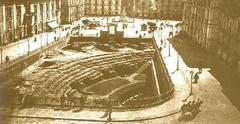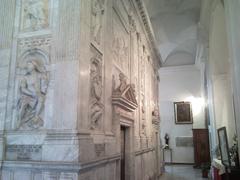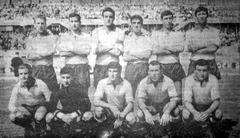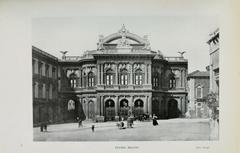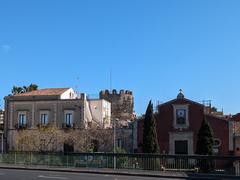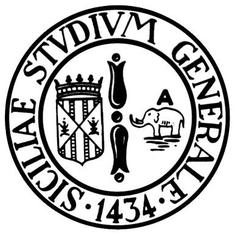Diocesan Museum Catania: Visiting Hours, Tickets, and Historical Sites Guide
Date: 04/07/2025
Introduction
The Diocesan Museum of Catania (Museo Diocesano di Catania) is a premier cultural institution in Sicily, renowned for its extensive collection of religious art, sacred treasures, and deep ties to Catania’s history. Located in the 18th-century Palazzo del Seminario dei Chierici, adjacent to the Cathedral of Sant’Agata in the heart of Piazza del Duomo, the museum offers an immersive journey into the spiritual, artistic, and civic legacy of the city. This comprehensive guide covers everything you need to plan your visit, including up-to-date information on visiting hours, ticketing, accessibility, highlights, and practical visitor tips. Whether you are a history buff, art lover, or a traveler keen to explore Catania’s most significant historical sites, the Diocesan Museum is an essential stop (WhichMuseum; Wikipedia; History of EU).
Table of Contents
- Introduction
- Origins and Architectural Context
- Development of the Museum and Collections
- Historical and Cultural Significance
- Museum Layout: Floor-by-Floor
- Key Highlights and Special Features
- Visiting Information
- Events, Exhibitions, and the Festival of Sant’Agata
- Visitor Tips and Recommendations
- Facilities and Amenities
- Frequently Asked Questions (FAQ)
- Conclusion and Call to Action
- References
Origins and Architectural Context
The museum is housed in the Palazzo del Seminario dei Chierici, a prime example of Sicilian Baroque architecture, constructed after the 1693 earthquake that reshaped Catania. Its ornate façade, elegant staircases, and integration with the adjacent Cathedral of Sant’Agata embody the city’s architectural and spiritual resilience (WhichMuseum). The building not only preserves invaluable religious artifacts but also serves as a living testament to Catania’s capacity for renewal and cultural continuity.
Development of the Museum and Collections
The Diocesan Museum was established to collect, safeguard, and exhibit the liturgical and artistic treasures of the Diocese of Catania. Its collections are organized into two main sections:
- Cathedral Furnishings: Liturgical silverwork, reliquaries, embroidered vestments, and processional objects used for centuries in the Cathedral of Sant’Agata.
- Artifacts from Other Churches: Paintings, sculptures, textiles, and sacred objects from parish churches across the Etna province, reflecting the region’s rich ecclesiastical heritage.
One of the museum’s most significant artifacts is the silver fercolo of Sant’Agata, an ornate processional carriage central to Catania’s annual festival (WhichMuseum).
Historical and Cultural Significance
The museum’s holdings document the deep-rooted veneration of Sant’Agata and the evolution of religious traditions in Catania. Many pieces survived natural disasters, such as the 1693 earthquake and Mount Etna’s eruptions, becoming symbols of local resilience. The Diocesan Museum also plays an active role in the city’s spiritual life, particularly during the celebrated Festival of Sant’Agata, and serves as an educational hub for the community (History of EU).
Museum Layout: Floor-by-Floor
Ground Floor
- Entrance and Orientation: Welcoming area with ticket desk, brochures, and maps.
- Sala 9: Home to the remarkable silver fercolo of Sant’Agata, centerpiece of the museum and the city’s famed February festival.
- Access to Roman Achillean Baths: Direct entry to the subterranean Roman-Imperial site beneath the museum.
First Floor
- Audiovisual Gallery: Multimedia presentations that introduce visitors to the museum’s collections and local history (Wikipedia).
Second Floor
- Liturgical Furnishings of the Cathedral: Silver chalices, monstrances, reliquaries, embroidered vestments, and devotional paintings.
- Chapel: A sacred space displaying important liturgical items in context (History of EU).
Third and Fourth Floors
- Pinacoteca: Paintings from the Renaissance to Baroque periods, depicting biblical scenes, saints, and episodes from the life of Sant’Agata.
- Sculptural Works: Wood, marble, and stucco statues from churches across the diocese.
- Additional Sacred Objects: Processional crosses, altar frontals, and ceremonial banners (Visit Catania).
Panoramic Terraces
- Terrace Views: Spectacular vistas over Piazza del Duomo, Via Etnea, Mount Etna, and the Baroque skyline. Particularly popular during festivals and for photography (Wikipedia; History of EU).
Key Highlights and Special Features
- Silver Fercolo of Sant’Agata: An exceptional processional carriage, centerpiece of the annual festival.
- Roman Achillean Baths: Subterranean archaeological site with vaulted chambers and the Amenano river.
- Porta Uzeda Terraces: Panoramic viewpoints offering alternative perspectives of Catania’s historic port and fortifications.
- Special Collections: Jewel-encrusted busts, ceremonial textiles, and rare manuscripts.
Visiting Information
Location and Access
- Address: Piazza Duomo – Via Etnea 8, 95124 Catania
- Nearby attractions: Cathedral of Sant’Agata, Piazza del Duomo, Bellini Theater, Roman Theatre (Ferrini Home).
Visiting Hours
- Monday to Saturday: 9:00 AM – 6:00 PM
- Sunday and Holidays: 10:00 AM – 2:00 PM
- Last admission: 30 minutes before closing
- Note: Hours may vary during festivals and summer months; always check the official museum website for current times.
Tickets and Admission
- General Admission: €5–€7 (depending on source and seasonal promotions)
- Reduced Admission: €3–€4 (students, seniors, groups)
- Free Entry: Children under 18 and Catania residents (with valid ID)
- Achilliane Spas Ticket: €5
- Combined Museum + Achilliane Spas: €10 (reduced €6)
- Panoramic Terraces Only: €3
- Where to buy: Tickets available at the entrance and online (Visit Catania).
Accessibility
- Wheelchair Accessible: Elevators and ramps throughout the museum; assistance available on request.
- Terraces: Not fully accessible to all visitors; check in advance if mobility is a concern.
Guided Tours and Educational Programs
- Languages: Italian, English; other languages by arrangement.
- Booking: Advance reservation recommended, especially for groups and school visits.
- Workshops: Educational activities for families and schools.
Travel Tips
- Recommended visit duration: 1.5–2 hours for museum and terraces.
- Best time to visit: Mornings on weekdays for fewer crowds; festival periods for unique experiences.
- Dress code: Modest attire recommended due to religious context.
- Photography: Permitted without flash; restrictions may apply in certain galleries.
Events, Exhibitions, and the Festival of Sant’Agata
The Diocesan Museum is a vibrant cultural venue, hosting:
- Temporary exhibitions: Rotating displays of sacred and contemporary art.
- Concerts and lectures: Especially during the “Catania Summer Fest” and other citywide events (Enjoy Sicilia - Catania Summer Fest).
- “Una notte al Museo”: Special evening openings with guided tours and performances (CataniaToday Events).
- Festival of Sant’Agata: Extended hours, guided tours, and display of key relics and artifacts.
Visitor Tips and Recommendations
- Advance booking: Recommended for guided tours, groups, and special events.
- Combine visits: Explore the museum alongside the Cathedral, Achillean Baths, and other Piazza Duomo attractions.
- Check for updates: Always verify visiting hours and current ticket prices before your trip.
- Family friendly: Educational workshops and family tours make it accessible for all ages.
- Amenities: Café, restrooms, cloakroom, and event spaces available.
Facilities and Amenities
- Café: Refreshments with a view of Piazza Duomo.
- Restrooms: Ground floor.
- Cloakroom: Available at the entrance.
- Museum shop: Books, souvenirs, and locally crafted religious items.
- Accessibility: Elevators and ramps for most exhibition spaces.
Frequently Asked Questions (FAQ)
Q: What are the Diocesan Museum of Catania visiting hours?
A: Monday to Saturday, 9:00 AM–6:00 PM; Sundays and holidays, 10:00 AM–2:00 PM. Last entry 30 minutes before closing.
Q: How much are tickets?
A: €5–€7 for adults, €3–€4 reduced; free for children under 18 and Catania residents.
Q: Is the museum wheelchair accessible?
A: Yes, most exhibition areas are accessible; some terraces may not be.
Q: Are guided tours available?
A: Yes, in Italian and English; other languages upon request and with advance booking.
Q: Can I visit the Achillean Baths from the museum?
A: Yes, there is direct access with a combined ticket.
Q: Is photography allowed?
A: Yes, without flash or tripods unless otherwise indicated.
Conclusion and Call to Action
The Diocesan Museum of Catania is a treasure trove of Sicilian religious art and history, offering visitors an unparalleled experience that blends sacred heritage, stunning architecture, and panoramic city views. For a truly memorable visit, check the latest opening times and ticket options on the official museum website, plan your trip to coincide with special events or the Festival of Sant’Agata, and consider booking a guided tour to deepen your understanding. Pair your museum visit with explorations of nearby cultural sites for a comprehensive Catania experience. For ongoing updates and travel advice, download the Audiala app and follow us on social media. Discover the heart of Catania through its most cherished museum.
References
- Diocesan Museum of Catania Visiting Hours, Tickets & Historical Guide, 2025, WhichMuseum (WhichMuseum)
- Visiting the Diocesan Museum of Catania: Hours, Tickets, and Historical Highlights, 2025, Wikipedia & History of EU (Wikipedia; History of EU)
- Visiting the Diocesan Museum of Catania: Hours, Tickets, and Insider Tips, 2025, Ferrini Home (Ferrini Home)
- Diocesan Museum of Catania Visiting Hours, Tickets, and Cultural Events Guide, 2025, Museo Diocesano Catania Official Site (Museo Diocesano Catania Official Site)
- Visit Catania: Museo Diocesano, 2025 (Visit Catania)
- History of EU: Diocesan Museum of Catania, 2025 (History of EU)
- Museo Diocesano Catania Official Site, 2025 (Museo Diocesano Catania Official Site)
